A number of different companies bought into the trend of utilising railmotors. Rigid-bodied examples were used as we have already noted, by the LB&SR/LSWR. Please see:
Steam Railcars – Part 2 – Dugald Drummond (LSWR) and Harry Wainwright (SECR)
The LNWR built six in 1905-7 and a more powerful unit with a dedicated trailer in 1910. Jenkinson and Lane describe these as being “undeniably stylish – probably more so than any others, save perhaps for those of the Furness and Great Central Railways.” [1: p15-16] The Furness Railway had two Railmotors, the Great Central had three. [1: p9]
The Midland Railway had two Railmotors. [1: p9] These units were what encouraged me to look at the railmotors throughout the UK as a model of one of these units was built in O-Gauge by my late father-in-law, in LMS livery. More about this later.
Somewhat later in the 20th century, after the grouping of railway companies the LNER and the LMSR looked at the possibility of using rigid-bodied steam railmotors. The technological improvements available by the 1920s meant that steam railmotors were worth the investment, particularly for routes most suited to their use. These will be considered in a later article in this series.
The LNWR’s Steam Railmotors

Between 1905 and 1907, the LNWR built six rigid-bodied steam railmotors with a powered bogie that could be removed via double doors at the front end. They could accommodate 48 passengers, all in third class. “The cars were fitted with electric lighting, and there was electric bell communication from the rear driving position and the footplate. All six were absorbed into the LMS fleet in 1923 and one, No. 3, survived to be nationalised in 1948, being withdrawn in February that year.” [2][4: p57-59]
Jenkinson and Lane say that “the LNWR cars were especially well built and were technically interesting by way of employing an inside-cylindered power unit. This certainly made them less grotesque when seen in motion from the outside, and almost certainly made them more comfortable in ride quality, if only because the cylinders were nearer to the carriage centre line. They also lasted better than most and even the ruthless LMS style of management found use for them until the late 1920s/early 1930s. One lasted (just) until BR days, and when it was withdrawn from the Moffat branch of the old Caledonian Railway in 1948, it had become the final survivor of any of its kind in Great Britain.” [1: p16]
A fascinating insight into LNWR practice can be found in the June 2024 edition of Bus Archive News (No. 25) which was sent to me by Glyn Bowen.
A 1906 timetable is included in the newsletter for early motor bus services in North Wales provided by London & North Western Railway, as well as the steam-powered railmotor car services it operated on two branch lines. The railmotor and bus services began in 1905 associated with two LNWR branch lines, Prestatyn to Dyserth and Bangor to Bethesda. Three timetable extracts from 1906 appear below. [22]
The LNWR pulled its buses out of the area in 1915.
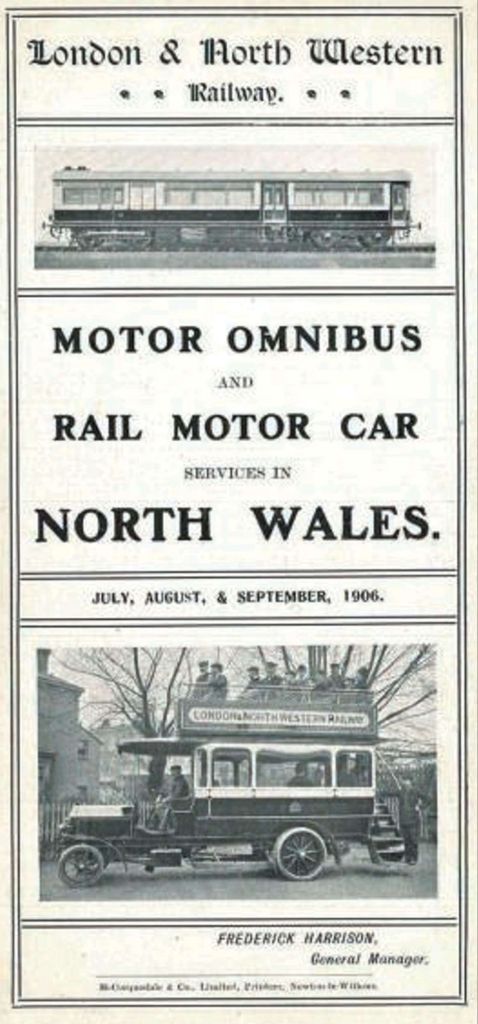
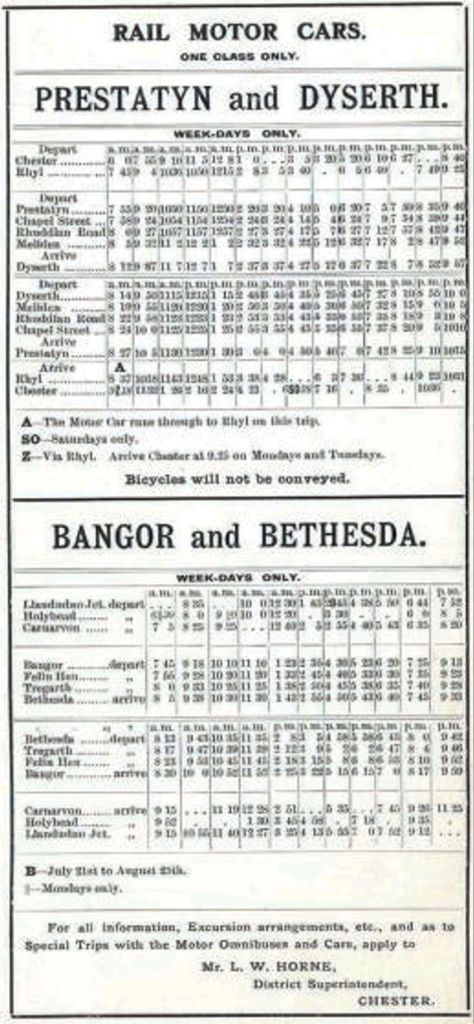
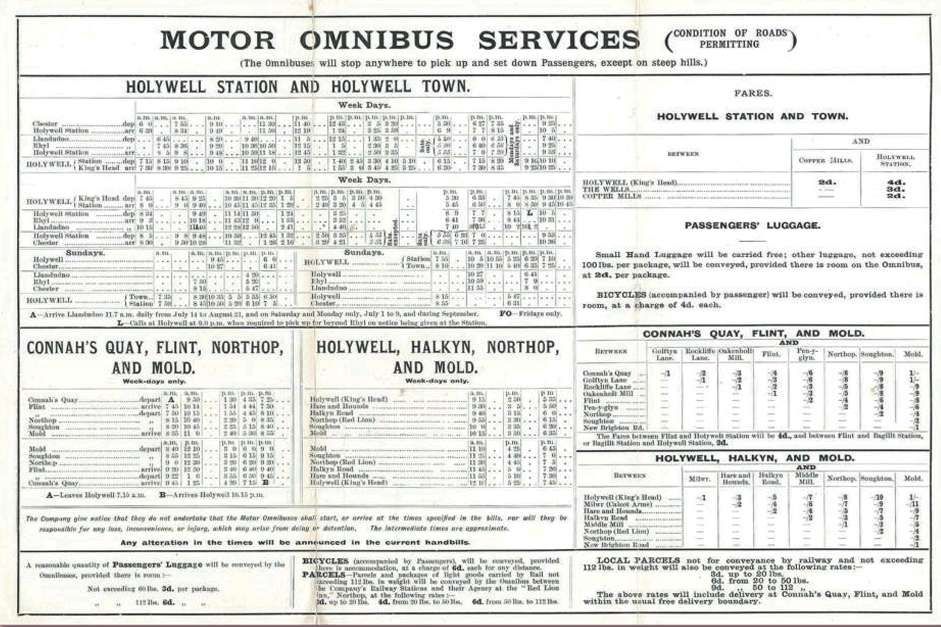
The Furness Railway Railmotor

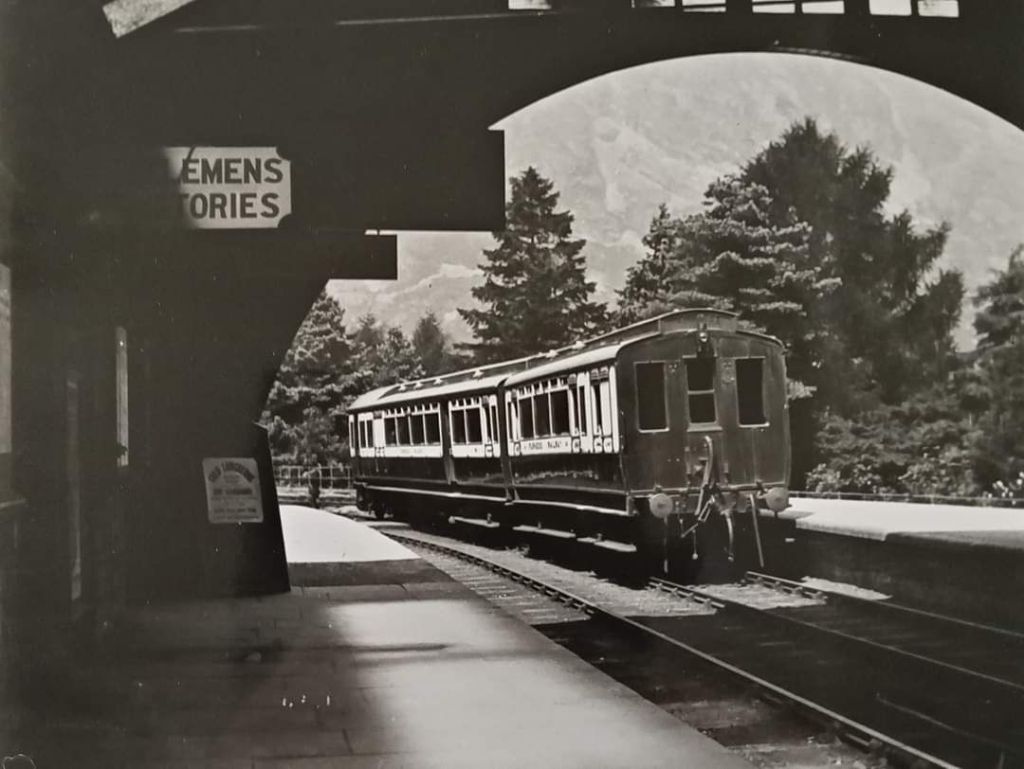
The Furness Railway Trust tells us that in 1905, the Furness Railway (FR) had two steam railmotors built. “Designed by W.F. Pettigrew, they were built at Barrow Works. The four-coupled railmotor cars were for use on the FR’s Coniston and Lakeside branches. Set No.2 was written off early in it’s career after a rumoured encounter with a buffer-stop, its classmate No.1 was withdrawn after some nine or ten years’ service on account of excessive vibration.” [20]
Jenkinson and Lane also talk of two railmotor. They say that the sets were “a highly attractive pair of steam railcars with equally good looking four-wheel trailers. … The clerestory form (for the passenger areas only) was distinctly unusual for a steam railcar.” [1: p18] Both, according to Jenkinson and Lane, were out-of-service by 1914.
The Great Central Railway Railmotors

Jenkinson and Lane have one photograph (of No. 1, at Barton Station presumably working the Barton-New Holland service) and a drawing at 4mm =1ft. [1: p18] They comment that, “the three Great Central railcars of 1904-5 were stylish units which bore a striking similarity to LNWR cars and also carried a slight hint of the contemporary locomotive hauled stock of the GCR in their visual lines. … In the brown and french grey livery of the period, the three railcars made a handsome sight.” [1: p18]
A Kent & East Sussex Railmotor
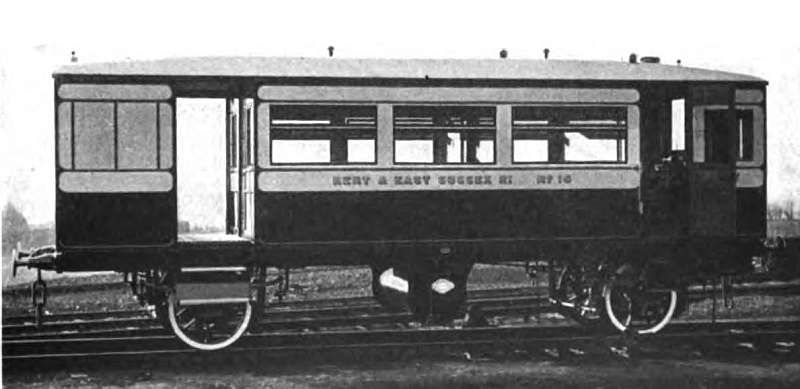
The K&ESR had one rigid-bodied four-wheeled steam railmotor. It had a steam motor. It had a high speed steam engine together with a form of gearing. Built in 1905 by R.Y. Pickering, “this could seat 31 passengers, but suffered poor ride quality and was taken out of use. It remained on the stock list when the railway was nationalised in 1948.” [2] [4: p110]
The Midland Railway Railmotors


The Midland Railway only had two [14] early Steam Railmotors which were numbered 2233 and 2234.
The Midland Railway Society produced a monograph about the Midland Railmotors in 2008. Details can be found here. [21]
Jenkinson and Lane tell us that the Midland railmotors “were not the best of their kind, either in technicalities or appearance. Their outside styling was vaguely reminiscent of the Midland’s turn of the century square panelled stock, but without the famous clerestory and the first power units were unreliable and had to be changed. The interiors displayed unpleasant pierced plywood seating whose comfort is best left to the imagination. However, one was converted into an officers’ saloon and as such, rescued by the NRM.” [1: p16]
The Midland Railway steam railmotors were in service only from 1904 until 1907 on the Morecambe to Heysham line. “The Heysham to Morecambe line was electrified on 13th April 1908, extended to Lancaster Green Ayre on 8th June 1908 and to Lancaster Castle on 14th September 1908.” [18] No.2234 was stored until 1917 when the boiler and engine were removed. It was converted by the Midland Railway to become an officer’s saloon for directors and officials. It was hauled by a conventional locomotive across the Midland network when lines needed inspecting, or special visits were made. [15]
“It was preserved in 1968 and became a holiday home in Machynlleth until the National Railway Museum bought it in the late 1970s. It is mahogany and teak and the ‘rooms’ are as they were when it was an officers’ saloon.” [15]
Some years ago now, my father-in-law built an O-Gauge model of one of the Midland Steam Railmotors. He painted it in LMS livery. These next few pictures show the model which now sits in a display case in our lounge on top of my wife’s piano. It was this model which provoked my reading around the different steam railmotors which were in use in the early 20th century.


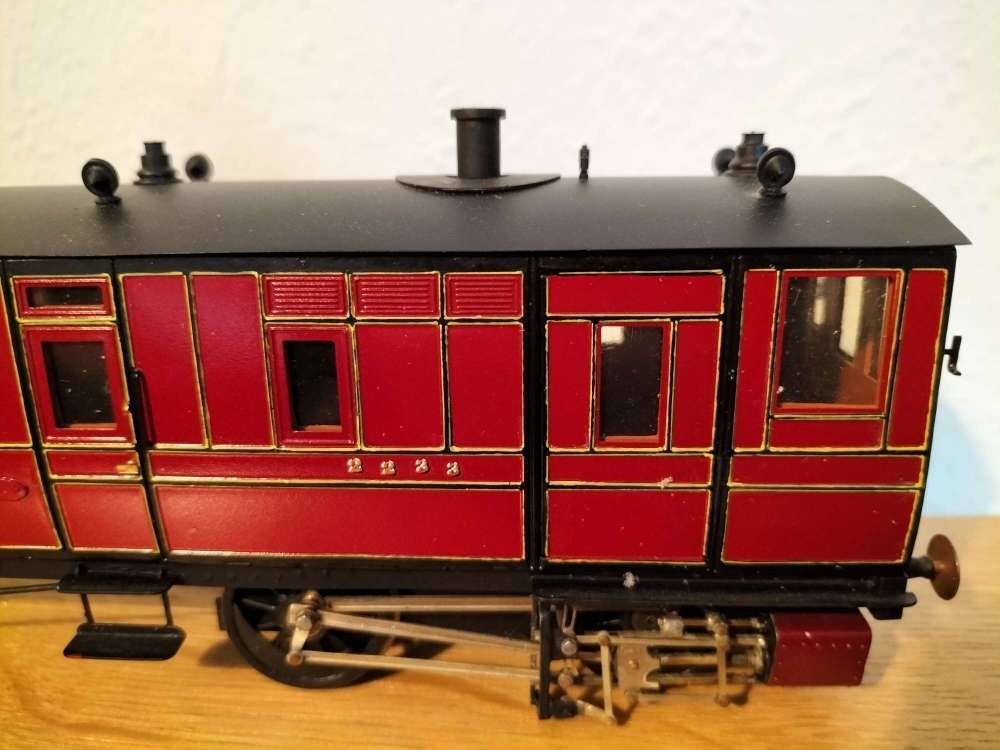
The Barry Railway Railmotors
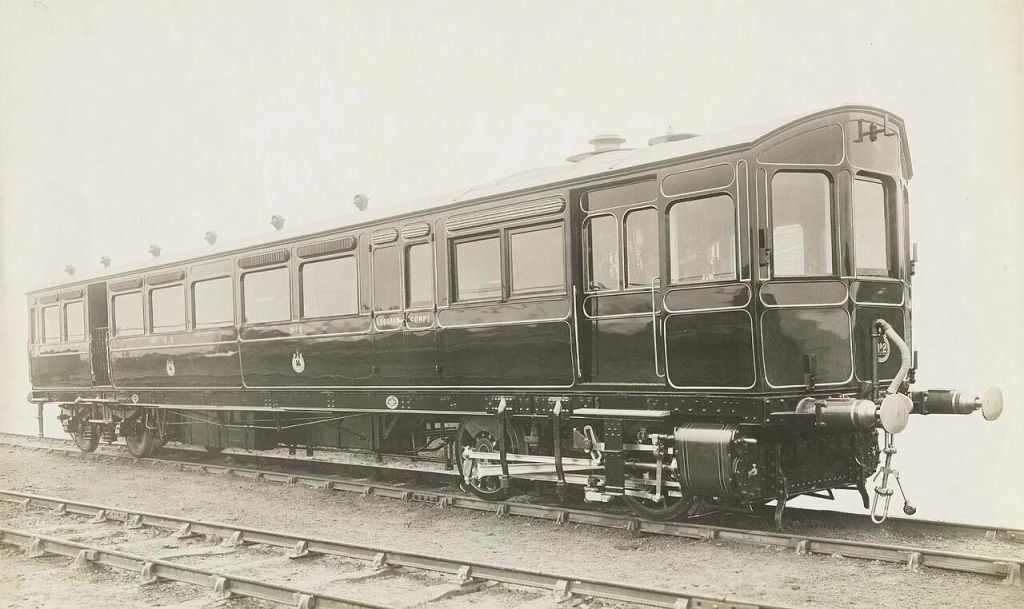
The Barry Railway purchased two steam railmotors from the North British Locomotive Co; “they were very similar to contemporary GWR railmotors. It ran the motor cars between Pontypridd and Cardiff via Tynycaeau Junction and St.Fagans. The service started on 1st May 1905, with the steam railmotors intermingled with conventional trains.” [13]
Warwickshirerailways.com displays a photograph of one of these two Railmotors after conversion to Auto-Trailer No. W4303 sitting in a siding at Widney Manor Railway Station in 1952. The webpage can be found here:
https://www.warwickshirerailways.com/gwr/gwrwm2627.htm
The webpage notes that the auto-coach started life as one of the two Steam Railmotors which were “built jointly by R.Y. Pickering & Co of Wishaw (near Glasgow) and the North British Locomotive Co. (Atlas Works, Glasgow) for the Barry Railway in 1905. R.Y. Pickering furnished and fitted the coach bodywork, while the North British provided the power unit – a vertical steam boiler and coupled four wheeled bogie with outside cylinders. The Steam Railmotor which would eventually become coach No W4303, was numbered No 2 by the Barry Railway. In 1914 both of the steam rail motors were converted at the Barry carriage repair shops into composite trailer coaches. This trailer coach was numbered No 178 and was recorded as having 12 second class and 56 third class seats. In 1921, No 178 together with the other trailer (No 177 converted from Steam Railmotor No 1) were regularly being used together on Barry to Bridgend services via the Vale of Glamorgan Line.” [13]
References
- David Jenkinson & Barry C. Lane; British Railcars: 1900-1950; Pendragon Partnership and Atlantic Transport Publishers, Penryn, Cornwall, 1996.
- https://en.m.wikipedia.org/wiki/British_steam_railcars, accessed on 14th June 2024.
- R.M. Tufnell; The British Railcar: AEC to HST; David and Charles, 1984.
- R.W. Rush; British Steam Railcars; Oakwood Press, 1970.
- https://victorianweb.org/victorian/technology/railways/locomotives/27.html, accessed on 16th June 2024.
- https://commons.m.wikimedia.org/wiki/File:Bicester_Town_railway_station.jpg, accessed on 18th June 2024.
- https://commons.m.wikimedia.org/wiki/File:KESR_steam_railcar_16_built_1905.jpg, accessed on 18th June 2024.
- Not used.
- Not used.
- Not used.
- Not used.
- https://commons.m.wikimedia.org/wiki/File:Barry_Railway_Steam_Railcar_1904.jpg, accessed on 18th June 2024.
- https://en.m.wikipedia.org/wiki/Barry_Railway_Company, accessed on 18th June 2024.
- Rush mentions one [4], Jenkinson lists 2 units in a summary table [1: p9]
- Sam Hewitt: Can We Also Save Midland Railway Steam Railmotor? In Heritage Railway Magazine, January 2019; via https://www.heritagerailway.co.uk/6651/can-we-also-save-midland-railway-steam-railmotor, accessed on 18th June 2024.
- https://www.gracesguide.co.uk/File:Im1904EnV98-p204a.jpg, accessed on 18th June 2024.
- https://www.gracesguide.co.uk/File:Im1963EnV216-p151a.jpg, accessed on 18th June 2024.
- https://glostransporthistory.visit-gloucestershire.co.uk/electrif.htm, accessed on 18th June 2024.
- https://www.prints-online.com/inst-mechanical-engineers/steam-rail-motor-coach-1-5082715.html, accessed on 18th June 2024.
- https://www.facebook.com/furnessrailwaytrust/photos/a.220682561319601/697678023620050/?type=3&app=fbl, accessed on 18th June 2024.
- Stephen Summers on; The Midland Railway Steam Motor Carriages; The Midland Railway Society, 2008. Details can be found on: http://nicwhe8.freehostia.com/pynot//railway/steam-railmotor/steam-railmotor.html, accessed on 24th June 2024.
- The Bus Archive News No. 25, June 2024.
- https://www.facebook.com/share/p/k2G2enDH4a279KRP, accessed on 28th June 2024.
- Furness Railway Trust: “There was only ever one Railmotor, plus one trailer.” See the comments on the Furness Railway Trust’s post on its Facebook Page, https://www.facebook.com/share/jo3Q37knF41nXHhB. In this particular post the Trust first talks of a second Railmotor which was written off very early in its career, before then confirming that there was only ever one railmotor.

